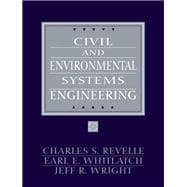
Note: Supplemental materials are not guaranteed with Rental or Used book purchases.
Purchase Benefits
What is included with this book?
The team of authors, ReVelle, Whitlatch, and Wright, is well credentialed to provide a text that delivers both solid technical content and quality communication. ReVelle, a professor at Johns Hopkins for more than 30 years, studied with one of the originators of systems analysis in water management and teaches a course in civil systems regularly. ReVelle is also the author, with his wife Penelope, of The Environment, a basic college text that has appeared in three editions, and more recently of The Global Environment. Whitlatch, a professor in civil engineering at Ohio State, has been teaching a popular and well-received civil systems course for over 25 years. Wright, the Dean of Engineering at University of California, Merced, and the founding editor-in-chief of The Journal of Infrastructure Systems, has been teaching courses on civil systems and engineering economics for more than 20 years. The authors have collaborated on research for three decades. All three authors have distinguished records of research and application. They enjoyed writing the text together and will be interested in your comments.
| Explaining Systems Analysis | |
| Models in Civil and Environmental Engineering | |
| A Graphical Solution Procedure and Further Examples | |
| The Simplex Algorithm for Solving Linear Programs | |
| Linear Programs with Multiple Objectives | |
| Linear Programming Models of Network Flow | |
| Integer Programming and Its Applications | |
| Scheduling Models: Critical Path Method | |
| Decision Theory | |
| Lessons in Context: Simulation and the Statistics of Prediction | |
| Lessons in Context: A Multigoal Water Resources Problem Utilizing Multiple Techniques | |
| Lessons in Context: Transportation Systems | |
| Dynamic Programming and Nonlinear Programming | |
| Engineering Economics I: Interest and Equivalence | |
| Engineering Economics II: Choice Between Alternatives | |
| Engineering Economics III: Depreciation, Taxes, Inflation, and Personal Financial Planning | |
| Table of Contents provided by Publisher. All Rights Reserved. |
The New copy of this book will include any supplemental materials advertised. Please check the title of the book to determine if it should include any access cards, study guides, lab manuals, CDs, etc.
The Used, Rental and eBook copies of this book are not guaranteed to include any supplemental materials. Typically, only the book itself is included. This is true even if the title states it includes any access cards, study guides, lab manuals, CDs, etc.